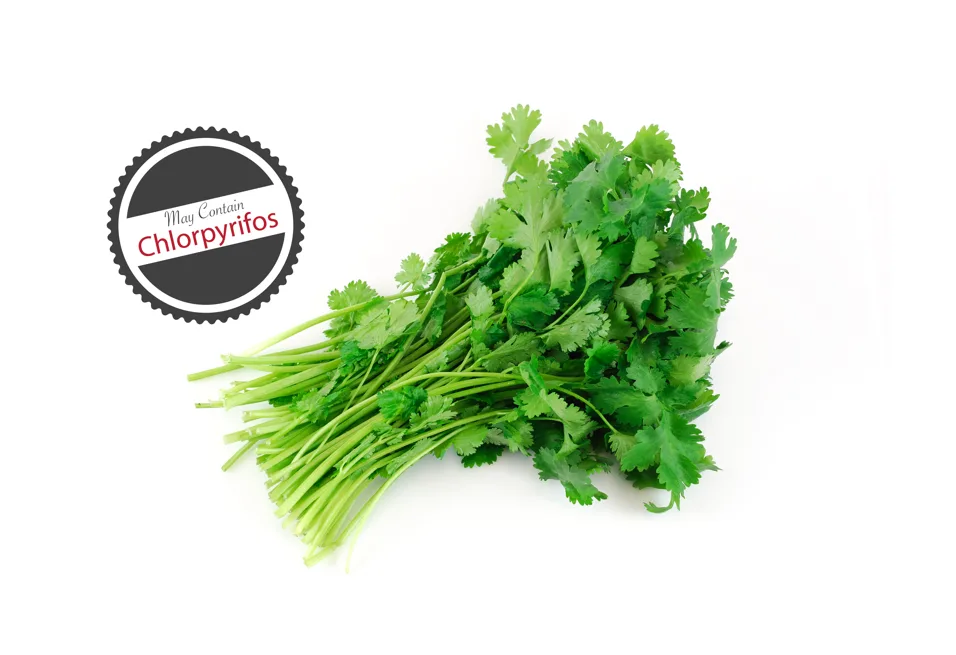Earlier this year, the EPA denied a petition to ban the use of Chlorpyrifos, an organophosphate insecticide, on food crops in the United States.1-3 This was surprising because, last year, the EPA concluded that there was “sufficient evidence that there are neurodevelopment effects occurring at chlorpyrifos exposure levels below (the current safety standard).”4 These neurodevelopment effects include: mental delay, attention disorders, ADHD, psychomotor delays, and pervasive developmental disorders.4
There are a several news articles that go into the background on chlorpyrifos and the EPA’s recent decision.3,5,6 However, after reading the articles, I still had a few questions. Specifically: what produce contain chlorpyrifos residue and how does the United States allowable residue levels compare with those of Canada and Europe?
Chlorpyrifos Residue on Produce
Every year, the USDA monitors pesticide residues on select fruits and vegetables and publishes the data through their Pesticide Data Program.7 These data are maintained in a database enabling anyone to search pesticide residue data for any combination of pesticides, produce, and years tested.8 Note: I discuss the USDA’s PDP in more depth in a post on Pesticides and Produce).
To learn more about chlorpyrifos residue on the produce we eat, I searched the USDA PDP’s database for all chlorpyrifos data from 2010 to 2015 (the most recent year data is available). In the past six years, the USDA PDP program identified 34 fruits and vegetables with measurable levels of chlorpyrifos residue:8
Apples
Asparagus
Bananas
Bell peppers
Broccoli
Cantaloupe
Carrots
Cauliflower
Celery
Cherries
Cherry tomatoes
Cilantro Cucumbers
Grapes
Green beans
Hot peppers
Lettuce
Mangos
Nectarines
Oranges
Peaches
Pears
Plums Potatoes
Raspberries
Snap peas
Soybean grain
Spinach
Strawberries
Summer squash
Sweet Potatoes
Tangerines
Tomatoes
Winter squash
Thirty four different fruits and vegetables with detectable chlorpyrifos residue may seem like a lot. However, it should be pointed out that several of these fruits and vegetables had a single or very few chlorpyrifos residue detection(see graph below). Also, the USDA PDP testing is neither comprehensive nor consistent. They test a select list of produce from multiple states per year. And the list of produce they test changes each year.7 Therefore, it is impossible to know if 34 different fruits or veggies testing positive for chlorpyrifos is a lot or a little.
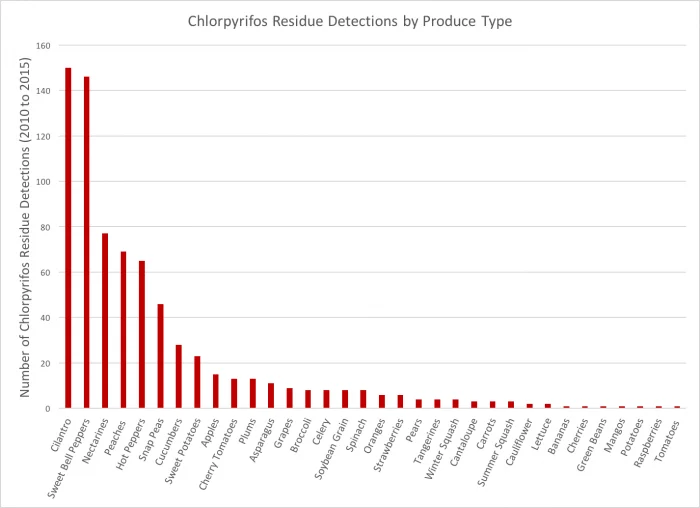
Produce Most Likely to Contain Chlorpyrifos Residue
Several fruits and vegetables consistently tested positive for chlorpyrifos residue. The top six include: cilantro, sweet bell peppers, nectarines, peaches, hot peppers, and snap peas.8
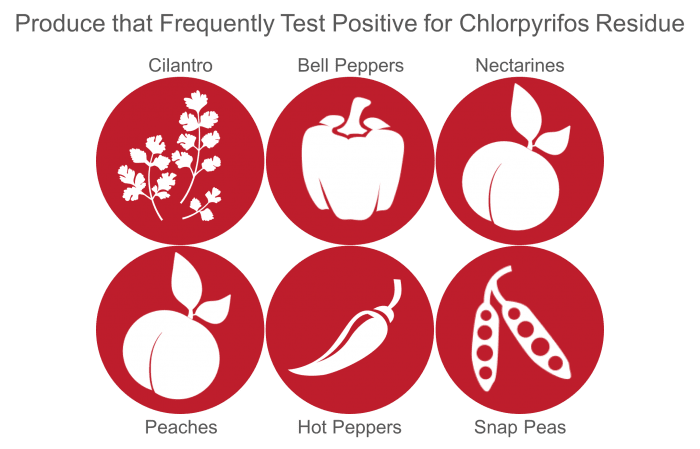
It would be wise to avoid fruits and vegetables that were found to frequently contain chlorpyrifos residue. However, in addition to knowing what produce most often contain chlorpyrifos residue, it is important to know which fruits and veggies contain the highest levels of chlorpyrifos residue.
Actual Detected Levels of Chlorpyrifos Residue
To determine which produce contained the highest level of chlorpyrifos residue, I again searched the USDA PDP’s database for chlorpyrifos.8 This time, I sorted the data for the maximum detected residue (in parts per million). Below is a table highlighting the five highest levels of chlorpyrifos residue on produce detected between 2010 and 2015.
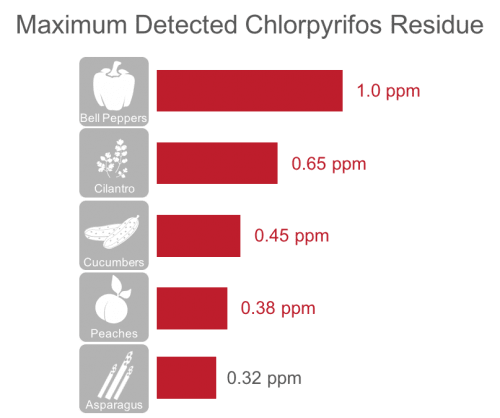
The values in the above table indicate the highest level of pesticide detected for that particular fruit or vegetable. Not all produce tested will have residue levels this high. However, the above listed produce consistently had high levels of detected chlorpyrifos residue (i.e. the above numbers are not outliers). If the number is colored red, it means that the particular value meets or exceeds the US allowable limit for that particular fruit or vegetable.
Allowable Levels of Chlorpyrifos Residue on Produce
When looking into the maximum residue limit (MRL) of pesticides allowed on produce, it should be noted that the MRL varies depending on the specific crop. This means that different levels of pesticide residue are allowed on different types of crops. And different countries allow different levels of pesticide residues on different crops. Below is a table summarizing the MRL data for the US, Canada, and Europe.9-11
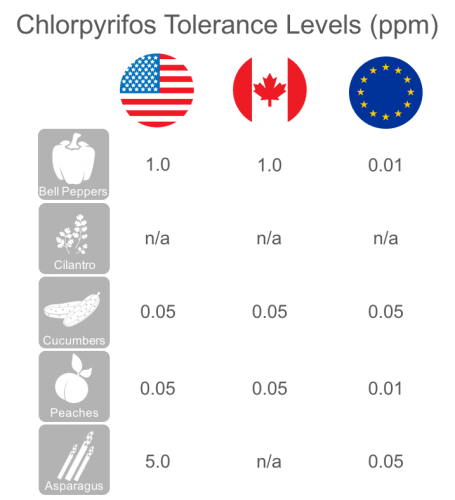
Why does the United States consider a chlorpyrifos residue of up to 1.0 ppm on sweet bell peppers a safe limit, but only 0.05 ppm on peaches or nectarines? I couldn’t find an explanation in the EPA code of federal regulations that lists tolerances. I also couldn’t find a justification for why asparagus was allowed to have up to 5.0 ppm chlorpyrifos residue.9
It is worth noting that the EU has significantly lower allowable levels of chlorpyrifos residue for peppers and stone fruit, such as peaches, than either the US or Canada. This is because the European Union recently lowered the MRLs for those crops (including peaches and peppers) after concluding that the allowed chlorpyrifos residue levels allowed on many fruits and vegetables “may raise concerns of consumer protection.”11
Summary
There is a growing body of data indicating a strong association between organophosphate pesticides and neurological problems (chlorpyrifos is one of many). Though the majority of the scientific data are for farm workers who have daily exposure to the pesticides, there is a small subset of clinical data that warrant rethinking our current position on using chlorpyrifos and other organophosphate pesticides in agriculture (for more information, read the post on Pesticides and Produce).
Even though the EPA has decided not to ban the use of chlorpyrifos in farming applications, we can make a conscientious decision to reduce our exposure to chlorpyrifos and other organophosphate pesticides.
How to reduce exposure to chlorpyrifos residue on produce:
- Avoid produce with high levels of chlorpyrifos residue
- Avoid produce that frequently test positive for chlorpyrifos residue
- Purchasing produce grown without organophosphate pesticides (buy organic or from a farmer who verifies the produce is pesticide-free)
Personally, I feel eating foods with chlorpyrifos residue is not worth the risk. I go out of my way to purchase organic cilantro, bell peppers, peaches and nectarines. And after researching this post, I am going to add asparagus and cucumbers to my “organic or pesticide-free only” list.
References:
- Chlorpyrifos, EPA Website (link)
- EPA Decision on Chlorpyrifos, EPA Website (link)
- EPA won’t ban pesticide chlorpyrifos; is it safe? March 2017, CNN Website (link)
- Chlorpyrifos Revised Human Health Risk Assessment (Summary of Literature Review on Neurodevelopmental Effects pages 10-12), Nov 2016, EPA Website (link)
- EPA Decides Not To Ban A Pesticide, Despite Its Own Evidence Of Risk, March 2017, The Salt, NPR Website (link)
- A Strong Case Against A Pesticide Does Not Faze E.P.A Under Trump, May 2017, The New York Times Website (link)
- USDA Pesticide Data Program, USDA Website (link)
- USDA Pesticide Data Program Database, USDA Website (link)
- Chlorpyrifos; EPA tolerances for residues, §180.342 eCFR Website, (link)
- Maximum Residue Limits for Pesticides, Health Canada Website (link)
- European Union amended MRLs for chlorpyrifos, Reg. (EU) 2016/60, Jan 2016, (link)
